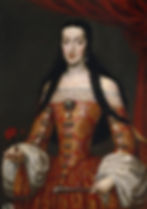The sad, sick and ugly king of Spain
- adriangvega
- 21 sept 2022
- 3 Min. de lectura
Actualizado: 18 oct 2022
It is the year 1661 and the Gazeta de Madrid describes the birth of the future king of Spain, Carlos II, as follows: "...a robust man with very beautiful features, a proportionate head, black hair and somewhat bulging flesh." However, after the visit of the French ambassador to the royal court to congratulate his parents, he summed up his impression as follows:
“The prince seems quite weak. He shows signs of degeneration; he has phlegm on his cheeks, his head is full of scabs and his neck is oozing (…) he is scary ugly”

At the time of his birth he was not the direct heir to the throne since he had an older brother, but five days after his birth he died, leaving Carlos as his only successor. The boy Carlos did not promise as ruler of one of the most important empires in the world. He had difficulties learning to walk, talk, read and at 15 years old he did not know how to write more than his own signature. Few had any hope that the young man would live to adulthood and therefore he did not have a proper education for the tasks that his position required.
A diplomatic representative of the Holy See, seeing the figure of the young king, commented:
“The king is rather short than tall, not ill-formed, ugly in face; he has a long neck, a long face and as if curved upwards; the typical lower lip of the Austrians; not very large eyes, turquoise blue and fine and delicate complexion. His hair is blonde and long, and he wears it slicked back so that his ears are exposed. He can't straighten his body except when he walks, unless he leans against a wall, a table or something else. His body is as weak as his mind. From time to time he shows signs of intelligence, memory and a certain liveliness, but not now; usually he has a slow and indifferent look, clumsy and indolent, seeming dumbstruck. You can do with him what you want, because he has no will of his own.”
Maria Luisa of Orleans (niece of the king of France) was his wife since he was 18 years old. She never fell in love with her husband but she was very affectionate with him. However, he did seem to be very much in love with his wife, but there was a serious problem: she had not just gotten pregnant and produced a successor to the Spanish crown.

Poor Maria Luisa of Orleans, one afternoon after a horseback ride, began to feel severe stomach pains and that same night she died from colic miserere (an attack of appendicitis). The king was left depressed and the court tremendously worried about finding him another wife who would give the king the desired son.
They found that Mariana of Neoburg would be the best option since her parents had fathered 24 children and therefore the girl should be extremely fertile as well. However, the problem was not his women but the king's own impotence. Mariana de Neoburgo, despite being a beautiful woman with political abilities, was not popular at court and she was known as "the German" and "the brewer" because of her taste for beer. Aware of her weak position if she did not produce an heir, she faked 11 pregnancies and began to think about succession to the throne once her husband died. Obviously, she was in favor that the successor should be from the Habsburgs, however the French Bourbons coveted the Spanish throne with the same force.

The Dutch and the British feared that if a Bourbon came to the throne of Spain, France would become too powerful as it would inherit a major naval fleet and a huge empire in Europe, America and Asia. This would upset the traditional balance of power in Europe and leave France as the dominant superpower.
Finally, on November 1, 1700, at the age of 38, King Carlos II of Spain died, leaving the Bourbon Felipe de Anjou as his successor. The autopsy contains the following description of the body of the unfortunate king:
“He did not have a single drop of blood on his body. His heart was the size of a peppercorn, his lungs corroded, his intestines putrefied and gangrenous. He had a single pitch-black testicle and a head full of water.”